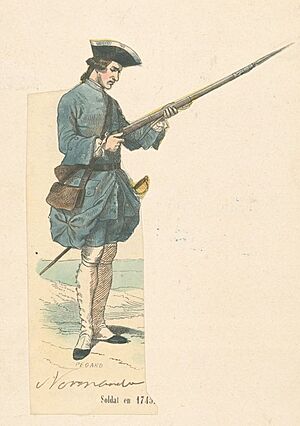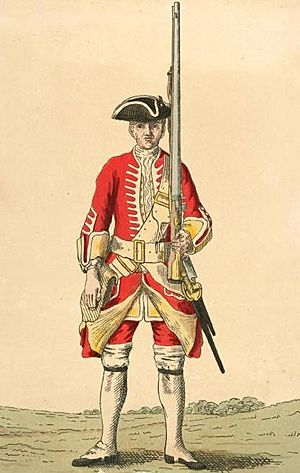Battle of Melle facts for kids
Quick facts for kids Battle of Melle |
|||||||
|---|---|---|---|---|---|---|---|
| Part of the War of the Austrian Succession | |||||||
|
|||||||
| Belligerents | |||||||
| Commanders and leaders | |||||||
| Strength | |||||||
| 6,000 to 8,000 | 4,000 to 6,000 | ||||||
| Casualties and losses | |||||||
| 200 killed or wounded | 500 killed or wounded 1,500 captured |
||||||
The Battle of Melle was a quick fight that happened on July 9, 1745. It was part of a bigger conflict called the War of the Austrian Succession. In this war, many European countries were fighting over who should rule Austria.
The battle took place in Melle, a town in what was then the Austrian Netherlands (modern-day Belgium). It was fought between the French army and a group of armies called the Allies. The Allies included soldiers from Austria, Great Britain, Hanover, and the Dutch Republic.
Just before this battle, the French had won a major victory at Fontenoy in May. After that loss, the Allied commander, Duke of Cumberland, was under pressure. He needed to protect Brussels, an important city, and also Ghent, a key place for army supplies.
Cumberland tried to do both. He kept his main army near Brussels. But he also sent about 4,000 soldiers to help defend Ghent. These soldiers were led by a Hanoverian general named Moltke. On their way to Ghent, Moltke's troops ran into a French group. This French group, led by General du Chayla, was trying to stop anyone from reinforcing Ghent. The Allies were forced to retreat with many losses. Because of this defeat, Ghent surrendered to the French a few days later on July 13.
Why the Battle Happened
After their big win at Fontenoy, the French army, led by Marshal Saxe, was very strong. They started moving towards important Allied cities like Brussels and Ghent. This forced the Duke of Cumberland, the Allied commander, to decide which places to defend.
Ghent was very important because it held a lot of military supplies. Brussels also had supplies, but many had already been used. Cumberland decided to protect Brussels with his main army. However, he also sent some troops to make the army in Ghent stronger. He also ordered that supplies be moved out of Ghent.
Marshal Saxe sent General du Chayla with a group of soldiers to Melle. Melle was a small town between Aalst and Ghent. Du Chayla's group included about 6,000 to 8,000 soldiers. They had infantry (foot soldiers), light infantry (fast-moving soldiers), and cavalry (soldiers on horseback). They also had about twenty small cannons and equipment to build pontoon bridges. Their job was to set up a camp and stop any Allied troops from reaching Ghent.
General Moltke's Allied force was made up of about 4,000 to 6,000 soldiers. These included British, Hanoverian, Dutch, and Austrian troops. They had infantry regiments and several squadrons of cavalry, including dragoons and hussars. Moltke's orders were to get as many of these troops as possible into Ghent from Aalst.
The Fight at Melle
On July 9, French light troops, called Grassins, moved towards Aalst. They took over a strong, walled building called the Château de Massemen, near Melle. Moltke sent some of his British soldiers, the Royal Scots, to push them out. A fierce gunfight started, but the Royal Scots couldn't remove the Grassins without cannons. So, the Royal Scots rejoined Moltke's main group. Moltke then decided to keep moving towards Ghent, leaving the Grassins behind them.
The French under Du Chayla were surprised when the Allies arrived. Their soldiers were spread out, setting up camp. Their cannons were lined up along the road, but they weren't ready for battle. A stone bridge and a walled priory (a type of monastery) along the road were not well guarded.
Moltke, leading about 1,700 soldiers, charged first. They crossed the bridge and quickly defeated a French battalion. They then rushed forward and captured the French cannons. But since the cannons weren't set up for firing, the Allies couldn't use them. More French soldiers arrived and started fighting the Royal Scots. The ground was difficult for cavalry, so the Allied horsemen couldn't help much.
During the intense gunfight, Moltke decided to try and reach Ghent with some of his cavalry. A small group of French cavalry tried to stop them. More French soldiers arrived, forcing Moltke's group off the main road. A French battalion then cut off the road behind them. Moltke and his cavalry broke away and rode towards Ghent. They had to pass through French positions, losing about half of their force, including many Royal Scots soldiers.
Meanwhile, Brigadier Thomas Bligh arrived with his British regiment, the 20th Foot, and some Dutch cavalry. Moltke was gone, so Bligh took command of about 1,450 infantry and 1,000 cavalry. The ground was still bad for cavalry, and the French were firing from all sides. Bligh pulled his troops back to a better position behind a small stream. This protected them from French fire and made it harder for French cavalry to attack.
The French, now with more soldiers and cannons, counter-attacked. While the two sides were fighting, the Grassins, who Moltke had left behind, arrived in Bligh's rear. They captured all the Allied supplies and cut off their escape route back to Aalst.
Seeing that his whole force was in danger, Bligh decided to retreat around 9 p.m. His troops withdrew in some confusion through woods and fields. They avoided the main road until they were close to Aalst. Bligh's force suffered heavy losses and lost all their supplies.
Aftermath
The defeat at Melle meant that Ghent could not get any more help. Marshal Saxe sent another 15,000 French troops to surround the city completely. The French began digging trenches closer to the city walls. The Dutch governor of Ghent soon surrendered.
The city of Ghent fell to the French on July 11. The French captured a huge amount of supplies and materials. They also captured the Allied soldiers inside, including Dutch troops and about 700 British soldiers. The citadel (a strong fortress) of Ghent fell a few days later on July 15. After this, the French quickly captured other important cities like Bruges and Oudenarde on July 19.
Images for kids





